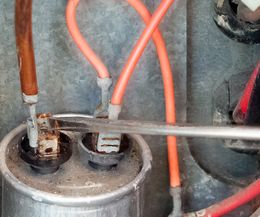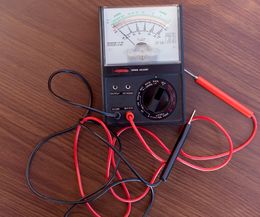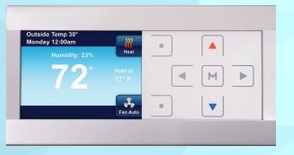 Thermostats: The Tools That Manage HVAC Performance
Thermostats: The Tools That Manage HVAC Performance
In basic definition, thermostats and advanaced A/C system controls in air conditioning and heat pump systems are on/off switches. The switch functions in relationship to a thermostat’s set point as compared to changes in the indoor air temperature of the associated structure. But there is so much more to HVAC performance than what meets the casual examination.
Herein, the Arizona-based HVAC installation and maintenance group at American Cooling and Heating presents a brief overview of air conditioning and heat pump thermostats & advanced A/C system controls.
Basic Thermostat and A/C System Control Processes
In 1883, Warren S. Johnson invented the first electric room thermostat. The Johnson Controls technology used mercury and electrodes inserted directly through the glass. The systems were accurate within one degree of temperature.
Skip ahead. In modern technology, most 2014 air conditioning and heat pump thermostats operate on low voltage control circuits that pull 24 volts AC from a control transformer installed within the home’s heating or cooling equipment. Low voltage control technology provides a safety advantage that enables the thermostat to operate multiple electromechanical contractors, relays and sequencers at inherently safe voltage. Modern systems also include an integrated “anticipation” function that activates the contacts in a manner that prevents room temperatures from overshooting the desired temperature settings. And all this excludes the growing range of features associated with modern programmable thermostats & controllers.
Pre-digital Heating and Air Conditioning Thermostats
In 1953, Honeywell introduced the T-86 “Round” thermostat technology (1). This bimetallic-spring regulated room thermostat still controls millions of home heating and cooling systems throughout the world.
Typically mounted on a central wall within the home, the traditional Honeywell thermostat uses a basic dial-type round-controller design that includes two temperature scales and two temperature pointers. The top scale and pointer provides the adjustable components of the system. The bottom scale shows the actual physical temperature in the chosen area of the home. Rotating the pointer in the top scale to the right increases the desired heating requirements. Rotating the pointer in the top scale to the left decreases the desired temperature setting.
In the early years, thermostats designed to control both cooling and heating included a manual setting switch at the base of the unit. This switch, also seen in rectangular units of the pre-digital era, can be moved from heat-to-off-to-cool or back again. The temperature sensor within the units compare the air temperature near the thermostat to the settings of the system and turn on or off the associated heating or cooling equipment as appropriate. The heat/cool/off control switch assures that only the selected equipment can activate at any one time.
Digital Era Thermostats and Controllers
By the year 2005, nearly 97% of U.S. households used installed heating systems (2). During the same time frame, only 75% of the U.S. households used air conditioning. But the world is changing and the changing climates associated with global warming continue to press upward the demand for installed home air conditioning. Modern programmable thermostat and controller technology bestows a dramatic increase in features and capabilities. From simple on/off heating and cooling to controlled ventilation systems and from manual settings to controllers that respond to electricity price signals the home air conditioning and heat pump management system engages in a whole new arena of thermal comfort and energy savings. And then along comes thermostats and advanced air conditioning controls that link directly into the home Internet networking system.
A Sampling of Thermostats and Controllers Available Via ACH
For homeowners and the HVAC industry, heating and cooling control is blazing a whole new world of opportunities. Here are some examples of thermostats and controllers offered to Arizona residents and installed by American Cooling and Heating:
Trane XL800 Digital Thermostat
Quality remains at the core of every Trane thermostat. Rely on the comfort. Trust the power of the Trane XL800 Deluxe Programmable to provide:
- Bright back-lit display with interactive touch screen
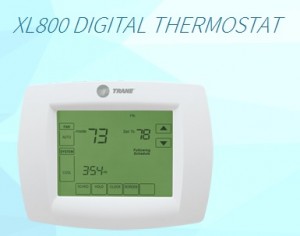
- Armchair programming with removable screen
- Filter clean/replacement key
- Programming functions stored in permanent memory
- Manual or auto changeover
- Minimum compressor runtime
- 3 to 10 degrees Fahrenheit “dead band” between heating and cooling set points in the “auto” changeover mode
- Conventional or adaptive intelligent recovery
- Min and max heating and cooling ranges
- Daylight Savings Time key
- Programmable fan can be programmed in the “on”, “auto” or “circulate” mode for each period
- Vacation/leave program will hold vacation/leave temperature for up to 256 days
- Five-minute time delay for compressor protection
- Outdoor temperature display
- Single-stage heat (gas or electric), single-stage cool
- AND more.
Trane ComfortLink™ II SMART CONTROL
It’s innovative, fully upgradeable and the best that Trane offers. The ComfortLink™ II control features touch-screen configuration in a digital picture frame environment. Compatible with most brands of standard central heat pumps and air conditioning equipment as well as with Trane products, this controller enables Arizona homeowners with the power of the future. Features include:

- Custom control and scheduling
- Live weather and dealer contact via wireless networking
- Energy efficient indoor/outdoor temperature monitoring
- Air quality management designed to boost the efficiency of your air filter system
- Remote access from within your home or from any Internet-enabled mobile device
But these two only touch the surface. American Cooling and Heating also installs:
- Amana ComfortNet CTK03 Control
- Amana ComfortNet CTK01 Control
- Amana Digital Thermostats
- Goodman Standard Touch Screen Thermostats
- Goodman Communicating Thermostats
- Rheem 100-Series Non-Programmable Thermostats
- Rheem 200-Series Programmable Thermostats
- Rheem 300-Series Deluxe Programmable Thermostats
- Rheem 400-Series Special Applications and Programmable Thermostats
- Rheem 500-Series Communicating and Programmable Thermostats
- AND Other Equipment From Major Manufacturers.
American Cooling and Heating Offers Valley Wide Arizona Air Conditioning and Heating Sales, Installation and Services on residential, commercial and industrial equipment, including air conditioning condensers, air handlers, furnaces, heat pumps, refrigeration systems and other HVAC equipment.
Call now for more info:
- http://honeywell.com/About/Pages/our-history.aspx
- http://eec.ucdavis.edu/files/How_people_use_thermostats_in_homes.pdf
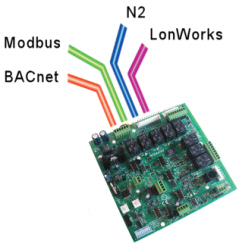 RTU-MP™ Carrier Commercial Rooftop Unit Controller
RTU-MP™ Carrier Commercial Rooftop Unit Controller